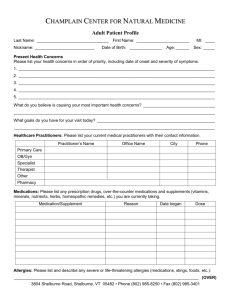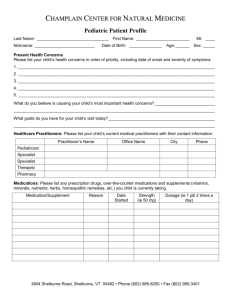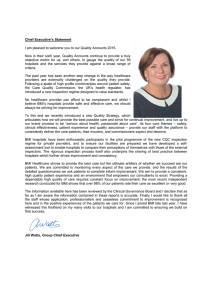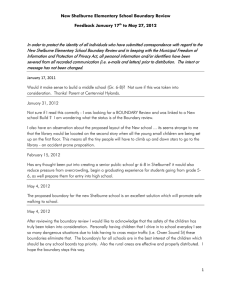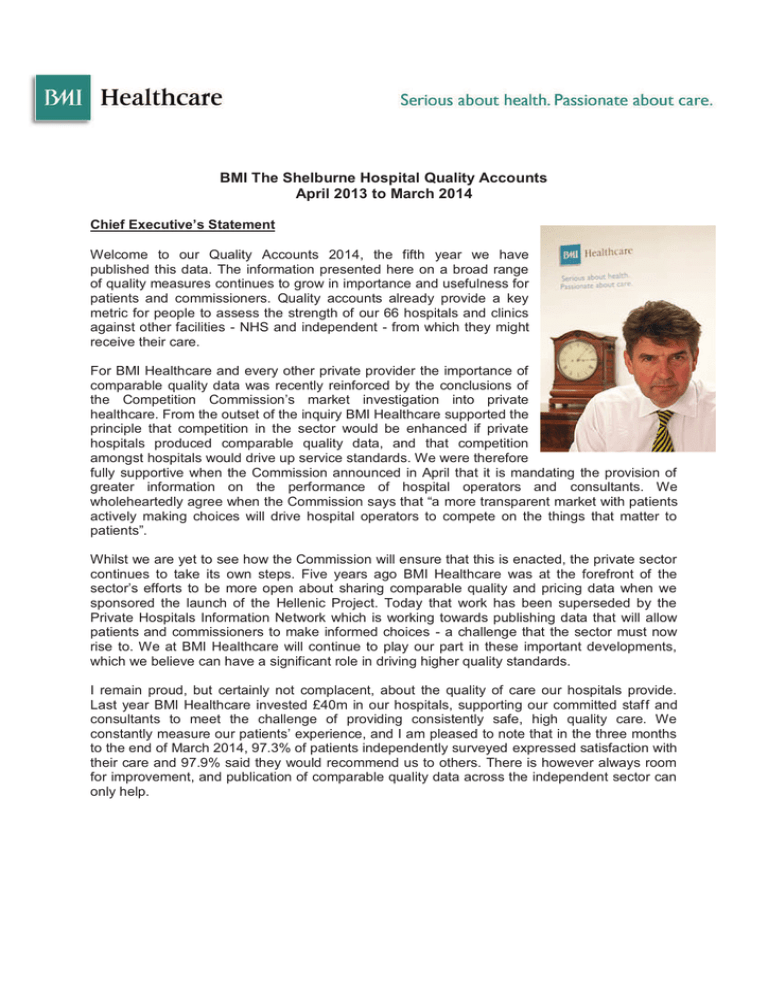
BMI The Shelburne Hospital Quality Accounts
April 2013 to March 2014
Chief Executive’s Statement
Welcome to our Quality Accounts 2014, the fifth year we have
published this data. The information presented here on a broad range
of quality measures continues to grow in importance and usefulness for
patients and commissioners. Quality accounts already provide a key
metric for people to assess the strength of our 66 hospitals and clinics
against other facilities - NHS and independent - from which they might
receive their care.
For BMI Healthcare and every other private provider the importance of
comparable quality data was recently reinforced by the conclusions of
the Competition Commission’s market investigation into private
healthcare. From the outset of the inquiry BMI Healthcare supported the
principle that competition in the sector would be enhanced if private
hospitals produced comparable quality data, and that competition
amongst hospitals would drive up service standards. We were therefore
fully supportive when the Commission announced in April that it is mandating the provision of
greater information on the performance of hospital operators and consultants. We
wholeheartedly agree when the Commission says that “a more transparent market with patients
actively making choices will drive hospital operators to compete on the things that matter to
patients”.
Whilst we are yet to see how the Commission will ensure that this is enacted, the private sector
continues to take its own steps. Five years ago BMI Healthcare was at the forefront of the
sector’s efforts to be more open about sharing comparable quality and pricing data when we
sponsored the launch of the Hellenic Project. Today that work has been superseded by the
Private Hospitals Information Network which is working towards publishing data that will allow
patients and commissioners to make informed choices - a challenge that the sector must now
rise to. We at BMI Healthcare will continue to play our part in these important developments,
which we believe can have a significant role in driving higher quality standards.
I remain proud, but certainly not complacent, about the quality of care our hospitals provide.
Last year BMI Healthcare invested £40m in our hospitals, supporting our committed staff and
consultants to meet the challenge of providing consistently safe, high quality care. We
constantly measure our patients’ experience, and I am pleased to note that in the three months
to the end of March 2014, 97.3% of patients independently surveyed expressed satisfaction with
their care and 97.9% said they would recommend us to others. There is however always room
for improvement, and publication of comparable quality data across the independent sector can
only help.
The information available in these quality accounts has been reviewed by the Clinical
Governance Board and I declare that as far as I am aware the information contained in these
reports is accurate. I thank all the staff whose energy and devotion to improvement is
represented here and, more importantly, in the experiences of every patient who steps across
our threshold.
Stephen Collier
Chief Executive Officer
Hospital Information
BMI The Shelburne Hospital is located within
the Wycombe Hospital site, in the heart of
High Wycombe. The Shelburne Hospital has
the latest technology, High Dependency Unit
facilities, Radiology and
Physiotherapy
Departments, 3 Theatres, 5 room consulting
suite and 29 beds, we are able to undertake a
wide range of procedures from routine
investigations to complex surgery.
There has been investment into the environmental aspects of the hospital this year, including
new flooring in some areas, minor decorating works, and replacement of televisions in patient
rooms.
During 2013 - 2014, 25% of the activity in BMI The Shelburne Hospital was NHS work. On
average, 57% of these cases were orthopaedic. This is an average of 40 cases per month of
both inpatient and day cases. The top ten procedures, which include hip and knee
replacements, joint injections and knee arthroscopies, make up 53% of the work throughout the
year. Knee arthroscopies account for 11% of the annual volume.
In January 2014 we launched our clinical strategy. The strategy has six core themes:
§
§
§
§
§
§
Putting patients at the heart of what we do
Our people are our most important attribute
Quality should underpin everything we do
Working together to grow our business
Engaging with Consultants
Being as cost-effective and efficient as possible.
We have also introduced new Lean ways of working to ensure that we deliver a smooth and
consistent service to our patients and effective ways of working for our staff. One element of
this is a series of Communication cells, which work in conjunction with creative problem solving.
Communication cells give everyone an opportunity to raise concerns and see through a
transparent process that their issue has been dealt with at an appropriate level.
The Lean Operating System acts as a foundation for the way that we work and helps us enrich
our culture, improve efficiency, and empowers staff to act which is having a positive effect on
engagement.
The creative problem solving has enabled us to identify areas of opportunity to make process
improvements, for example, we have developed an electronic booking form which speeds the
process and ensures that clear information is issued from the referring clinician. This enhanced
way of working is called ‘The BMI Way’ and is directly linked to our BMI Behaviours and is
introduced in such a way that our desired behaviours become engrained in our day to day
working lives.
BMI Healthcare are registered as a provider with the Care Quality Commission (CQC) under the
Health & Social Care Act 2008. BMI The Shelburne Hospital is registered as a location for the
following regulated services:Treatment of disease, disorder and injury
Surgical procedures
Diagnostic and screening
The CQC carried out an unannounced inspection on 19 February 2014 and found that the
following standards have been met:
Standards of safeguarding people who use the services from abuse
Standards of providing care and welfare of people who use the services
Standards of staffing
Standards of consent to care and treatment
Standards of assessing and monitoring the quality of service provision
The Shelburne Hospital has a local framework through which clinical effectiveness, clinical
incidents and clinical quality is monitored and analysed. Where appropriate, action is taken to
continuously improve the quality of care. This is through the work of a multidisciplinary group
and the Medical Advisory Committee.
Regional Clinical Quality Assurance Groups monitor and analyse trends and ensure that the
quality improvements are operationalised.
At corporate level the Clinical Governance Board has an overview and provides the strategic
leadership for corporate learning and quality improvement.
There has been ongoing focus on robust reporting of all incidents, near misses and outcomes.
Data quality has been improved by ongoing training and database improvements. New reporting
modules have increased the speed at which reports are available and the range of fields for
analysis. This ensures the availability of information for effective clinical governance with
implementation of appropriate actions to prevent recurrences in order to improve quality and
safety for patients, visitors and staff.
At present we provide full, standardised information to the NHS, including coding of procedures,
diagnoses and co-morbidities and PROMs for NHS patients.There are additional external
reporting requirements for CQC, Public Health England (Previously HPA) CCGs and Insurers
BMI is a founding member of the Private Healthcare Information Network (PHIN) UK – where
we produce a data set of all patient episodes approaching HES-equivalency and submit this to
PHIN for publication. The data is made available to common standards for inclusion in
comparative metrics, and is published on the PHIN website http://www.phin.org.uk. This website
gives patients information to help them choose or find out more about an independent hospital
including the ability to search by location and procedure.
1. Safety
1.1 Infection Prevention and Control
The focus on infection prevention and control continues under
the leadership of the Group Head of Infection Prevention and
Control, in liaison with the link nurse in The Shelburne Hospital.
The focus on infection prevention and control continues under
the leadership of the Group Director of Infection Prevention and
Control and Group Head of Infection Prevention and Control, in
liaison with the Infection Prevention and Control Lead at The
Shelburne Hospital.
We have had: Zero cases of MRSA bacteraemia in the last year (NHS 1.17cases/100,000 bed days).
Zero cases of MSSA bacteraemia /100,000 bed days
Zero cases of E.coli bacteraemia / 100,000 bed days
Zero of hospital apportioned Clostridium difficile in the last 12 months.
SSI data is also collected and submitted to Public Health England for orthopaedic
surgical procedures. Our rates of infection are;
o Hips = 1 SSI
o Knees = 0 SSI
The hospital has undertaken audits across a number of different areas, specifically focusing on:
Hand hygiene
Catheters
Environmental
Insertion of intravenous cannulas
Although we achieved high audit results, we continue to support our staff with focused activities
on hand hygiene, aseptic non touch technique and other infection prevention activities.
Environmental cleanliness is also an important factor in infection prevention and our patients
rate the cleanliness of our facilities highly. As a result of environmental audits, the carpet
cleaning schedules have been enhanced. It has been recommended that carpets are removed
and hard flooring introduced. This is now on a rolling replacement programme.
Environmental cleanliness is also an important factor in infection prevention and our patients
rate the cleanliness of our facilities highly.
The graph below details the patient satisfaction scores for 2013 – 2014 for room and bathroom
cleanliness scores of excellent and very good.
1.2 Patient Led Assessment of the Care Environment (PLACE)
We believe a patient should be cared for with compassion and dignity in a clean, safe environment.
Where standards fall short, they should be able to draw it to the attention of managers and hold the
service to account. PLACE assessments will provide motivation for improvement by providing a clear
message, directly from patients, about how the environment or services might be enhanced.
In 2013 we introduced PLACE, which is the new system for assessing the quality of the patient
environment, replacing the old Patient Environment Action Team (PEAT) inspections.
The assessments involve patients and staff who assess the hospital and how the environment
supports patient’s privacy and dignity, food, cleanliness and general building maintenance. It focuses
entirely on the care environment and does not cover clinical care provision or how well staff are
doing their job.
The results will show how hospitals are performing nationally and locally.
Shelburne Hospital:
The results for The
Cleanliness
Food
Privacy, Dignity and Wellbeing
Facilities
89.53%
90.48%
86.21%
87.69%
1.3 Venous Thrombo-embolism (VTE)
BMI Healthcare, holds VTE Exemplar Centre status by the Department of Health across its
whole network of hospitals including, The Shelburne Hospital. BMI Healthcare was awarded the
Best VTE Education Initiative Award category by Lifeblood in February 2013 and were the
Runners up in the Best VTE Patient Information category.
We see this as an important initiative to further assure patient safety and care. We audit our
compliance with our requirement to VTE risk assessment every patient who is admitted to our
facility and the results of our audit on this has shown us to be 100% compliant.
This
demonstrates that the systems in place for risk assessing patients are robust. Monitoring and
audit of this process will be maintained.
The Shelburne Hospital reports the incidence of Venous Thromboembolism (VTE) through the
corporate clinical incident system. It is acknowledged that the challenge is receiving information
for patients who may return to their GPs or other hospitals for diagnosis and/or treatment of VTE
post discharge from the Hospital. As such we may not be made aware of them. We continue to
work with our Consultants and referrers in order to ensure that we have as much data as
possible.
2. Effectiveness
2.1 Patient reported Outcomes (PROMS)
Patient Reported Outcome Measures (PROMs) are a means of collecting information on the
effectiveness of care delivered to NHS patients as perceived by the patients themselves.
PROMs is a Department of Health led programme.
Latest results can be found by going on the online SOLAR system provided to you by Quality
Health
For the current reporting period, the tables below demonstrate that the health gain between
Questionnaire 1 (pre-operative) and Questionnaire 2 (post–operative) for patients undergoing
hip replacement and knee replacement at The Shelburne Hospital.
Oxford Hip Score average
Apr 12 – Mar 13
Shelburne
Hospital
England
Q1
Q2
Health gain between reporting
periods
21.4
38.8
17.4
17.907
39.224
21.317
Copyright © 2011 Re-used with the permission of The Health and Social Care Information Centre. All rights reserved.'
Oxford Knee Score average
Apr 12 – Mar 13
Shelburne
Hospital
England
Q1
Q2
Health gain between reporting
periods
*
*
* Less than 30 patients going through
the process, meaning that the site
cannot be scored
18.893
34.902
16.01
Copyright © 2013, The Health and Social Care Information Centre. All Rights Reserved.
2.2 Enhanced Recovery Programme (ERP)
The ERP is about improving patient outcomes and speeding up a patient’s recovery after
surgery. ERP focuses on making sure patients are active participants in their own recovery and
always receive evidence based care at the right time. It is often referred to as rapid recovery, is
a new, evidence-based model of care that creates fitter patients who recover faster from major
surgery. It is the modern way for treating patients where day surgery is not appropriate.
ERP is based on the following principles:1. All Patients are on a pathway of care
a. Following best practice models of evidenced based care
b. Reduced length of stay
2. Patient Preparation
a. Pre Admission assessment undertaken
b. Group Education sessions
c. Optimizing the patient prior to admission – i.e HB optimisation, control comorbidities, medication assessment – stopping medication plan.
d. Commencement of discharge planning
3. Proactive patient management
a. Maintaining good pre-operative hydration
b. Minimising the risk of post-operative nausea and vomiting
c. Maintaining normothermia pre and post operatively
d. Early mobilisation
4. Encouraging patients have an active role in their recovery
a. Participate in the decision making process prior to surgery
b. Education of patient and family
c. Setting own goals daily
d. Participate in their discharge planning
At BMI The Shelburne Hospital we have monthly ERP meetings to ensure we are implementing
all the best practice principles of ERP. We are still in the early stages of implementing Hb
optimisation treatments, and aim to have this embed during 2014.
2.3 Unplanned Readmissions within 31 days and unplanned returns to theatre.
Unplanned readmissions and unplanned returns to theatre are normally due to a clinical
complication related to the original surgery.
3. Patient Experience
3.1 Patient Satisfaction
BMI Healthcare is committed to providing the highest levels of quality of care to all of our
patients. We continually monitor how we are performing by asking patients to complete a patient
satisfaction questionnaire. Patient satisfaction surveys are administered by an independent third
party. Below are the results, compared over the last two years for The Shelburne Hospital.
3.2 Complaints
In addition to providing all patients with an opportunity to complete a satisfaction survey BMI
The Shelburne actively encourages feedback both informally and formally. Patients are
supported through a robust complaints procedure, operated over three stages:
Stage 1:
Stage 2:
Stage 3:
Hospital resolution
Corporate resolution
Patients can refer their complaint to independent adjudication if they are not
satisfied with the outcome at the other 2 stages.
Every complaint is thoroughly investigated and the patient receives a written response. In
addition every effort is made to address the issues of concern to prevent a recurrence of any
similar issues to continuously improve the quality of care.
The general trend for complaints over the last 12 months has been in relation to charges for
diagnostic tests. In response to this we have increased communication throughout the hospital
informing patients that some tests carry an additional charge and ask that our consultants also
communicate this with patients during consultations.
4. CQUINS
Friends & Family Test
FFT Increased response rate
NHS Safety Thermometer
Safety thermometer survey data for all appropriate patients,
settings for relevant measures submitted
VTE Risk Assessment
% of Adult inpatient admissions reported as having had a VTE risk
assessment on admission to hospital using the clinical criteria of
the national tool
VTE Route Cause Analysis
Number of RCAs on confirmed cases of pulmonary embolism or
deep vein thrombosis whilst an inpatient
% of cases of hospital associated thrombosis where a root cause
analysis has been carried out
Surgical Care Bundle Audits: Catheters: Completion of monthly
audits
Number of patient records audited capturing surgical care
bundles per month
Post surgical remote follow up: increased number of patients
followed up remotely
Number of patients receiving post surgical telephone calls
Number of records audited in month (minimum 10)
Lifestyle interventions: identification of patients with BMI >30
Number of patient records audited with completed risk
assessment for weight associated health issues per month
Number of records audited in month (minimum of 10)
Quarter 4
Quarter 3
Quarter 2
INDICATORS
Quarter 1
Agreed CQUINS for 2013/4 are as follows:
13.92% 16.92% 13.89%
10.50%
Yes
Yes
Yes
Yes
100%
100%
100%
100%
0
1
1
0
100%
100%
100%
100%
0
17
30
30
0
22
0
20
22
75
44
75
30
20
75
75
30
20
75
75
5. National Clinical Audits
No of Procedures 2012
No of Consultants
Consent Rate %
Linkability %
Average ASA Grade
% Male Patients
Average Age at
Operation
% of 10A Rated
Acetabular Implant Hip
Primary Procedure
% of 10A Rated
Femoral Implant Hip
Primary Procedure
The Shelburne Hospital was only eligible to participate in National Joint Registry audit and all
joint replacements are submitted to this. BMI hospital data is from page 196 onwards in
attached latest NJS report. Use this if appropriate with your narrative on the data and any
improvement plans.
50
5
100%
96%
2.0
42%
70.3
15%
90%
6. Research
We did not undertake research during this period.
7. Priorities for Service Development and Improvement
The Shelburne Hospital plans to expand the respiratory service this year to include lung function
tests.
8. Mandatory Quality Indicators
8.1 The value and banding of the summary hospital-level mortality indicator (SHMI) for The
Shelburne Hospital for the reporting period.
Unit
*
Reporting Periods
(at least last two
reporting periods)
Oct 11 – Jun 13
National
Average
Highest National
Score
Lowest National
Score
1.0006
1.1822
0.6735
*The Shelburne Hospital is unable to provide figures on Summary of Hospital-level Mortality
Indicators as the publication is not available until October 2014.
8.2
(i) Groin hernia surgery
Unit
Reporting Periods
National
Highest National
Lowest National
Average
Score
Score
(at least last two
reporting periods)
*N/A
Apr 12 – Mar 13
0.083
0.157
0.014
*The Shelburne Hospital is unable to report on outcome measures scores for groin hernia
surgery as there were less than 30 patients going through the process, meaning that the site
cannot be scored.
(ii) Varicose vein surgery
Unit
Reporting Periods
National
Highest National
Lowest National
Average
Score
Score
(at least last two
reporting periods)
*N/A
Apr 12 – Mar 13
-8.738
8.172
-15.918
*The Shelburne Hospital is unable to report on outcome measures scores for varicose vein
surgery as there were less than 30 patients going through the process, meaning that the site
cannot be scored.
(iii) Hip replacement surgery
Unit
17.4
Reporting Periods
(at least last two
reporting periods)
Apr 12 – Mar 13
National
Average
Highest National
Score
Lowest National
Score
21.280
24.684
17.214
(iv) Knee replacement surgery during the reporting period.
Unit
Reporting Periods
National
Highest National
Lowest National
Average
Score
Score
(at least last two
reporting periods)
*N/A
Apr 12 – Mar 13
15.99
20.37
12.2
*The Shelburne Hospital is unable to report on outcome measures scores for knee replacement
surgery as there were less than 30 patients going through the process, meaning that the site
cannot be scored.
8.3 (i) The percentage of patients aged 0-14 readmitted to a hospital which forms part of The
Shelburne Hospital within 28 days of being discharged from a hospital which forms part of the
hospital during the reporting period.
Unit
Reporting Periods
National
Highest National
Average
Score
(at least last two
reporting periods)
*N/A
Apr 11 – Mar 12
11.45
14.35
*The Shelburne Hospital is not registered for paediatric patients.
Lowest National
Score
7.96
8.3.(ii)The percentage of patients aged 15 or over readmitted to a hospital which forms part of
The Shelburne Hospital within 28 days of being discharged from a hospital which forms part of
the hospital during the reporting period.
Unit
0.28
Reporting Periods
(at least last two
reporting periods)
Apr 11 – Mar 12
National
Average
Highest National
Score
Lowest National
Score
10.01
14.51
5.54
8.4 The Shelburne Hospital responsiveness to the personal needs of its patients during the
reporting period.
Unit
88.19%
Reporting Periods
(at least last two
reporting periods)
2012-2013
National
Average
Highest National
Score
Lowest National
Score
68.1
84.4
57.4
The Shelburne Hospital considers that this data is as described for the following reasons. We
strive to deliver high quality care. Our patient satisfaction questionnaire is not truly comparable
to that used in NHS.
8.5 The percentage of patients who were admitted to The Shelburne Hospital and who were risk
assessed for venous thromboembolism during the reporting period.
Unit
100%
Reporting Periods
(at least last two
reporting periods)
Apr 13 – Jan 14
National
Average
Highest National
Score
Lowest National
Score
96
100
79
The Shelburne Hospital considers that this data is as described for the following reasons. All our
patients are risk assessed at pre-operative assessment.
8.6 The rate per 100,000 bed days of cases of C difficile infection reported within The Shelburne
Hospital amongst patients aged 2 or over during the reporting period.
Unit
0
Reporting Periods
(at least last two
reporting periods)
Apr 12 – Mar 13
National
Average
Highest National
Score
Lowest National
Score
17.3
30.8
0
8.7 The number and, where available, rate of patient safety incidents reported within The
Shelburne Hospital during the reporting period, and the number and percentage of such patient
safety incidents that resulted in severe harm or death.
Number of patient safety incidents reported.
Unit
101
Reporting Periods
(at least last two
reporting periods)
Apr 12 – Mar 13
National
Average
Highest National
Score
Lowest National
Score
44.55
1,810
0
National
Average
Highest National
Score
Lowest National
Score
7.76
30.95
1.68
Rate of patient safety incidents reported.
Unit
3.18
Reporting Periods
(at least last two
reporting periods)
Apr 12 – Mar 13
Number of patient safety incidents that resulted in severe harm or death.
Unit
0
Reporting Periods
(at least last two
reporting periods)
Apr 12 – Mar 13
National
Average
Highest National
Score
Lowest National
Score
0.64
28
0
Percentage of patient safety incidents that resulted in severe harm or death.
Unit
0%
Reporting Periods
(at least last two
reporting periods)
Apr 12 – Mar 13
National
Average
Highest National
Score
Lowest National
Score
0.9
2.9
0.0
8.8 The percentage of staff employed by the (name of hospital) during the reporting period, who
would recommend The Shelburne Hospital as a provider of care to their family or friends.
Unit
58%
Reporting Periods
(at least last two
reporting periods)
2013
National
Average
Highest National
Score
Lowest National
Score
64.58
96.43
33.73
9. Non-Mandatory Quality Indicators
9.1 The percentage of patients who received care as inpatients or discharged from A &E during
the reporting period, who would recommend The Shelburne Hospital as a provider of care to
their family or friends.
Unit
Reporting Periods
(at least last two
reporting periods)
National
Average
Highest National
Score
Lowest National
Score
72.45%
Jun 13 – Jan 14
66.23
94.38
35.63

